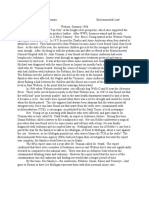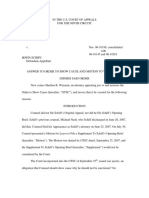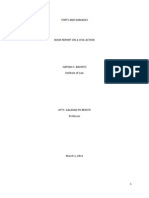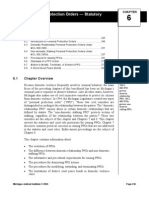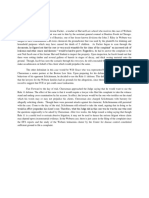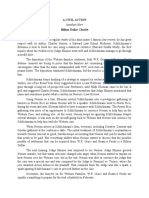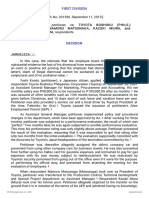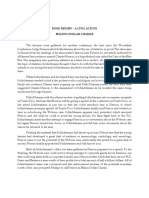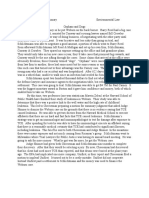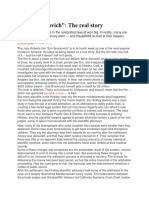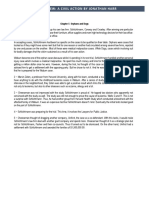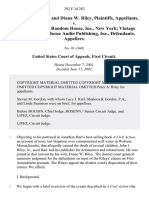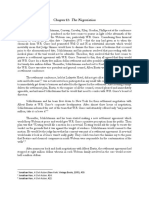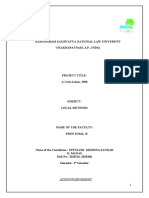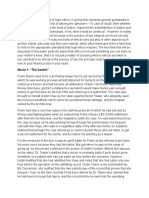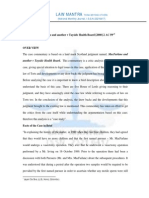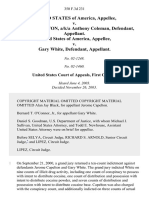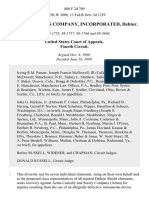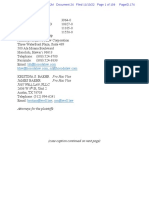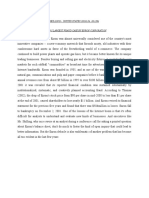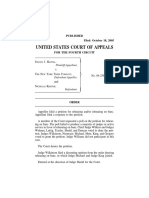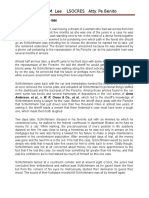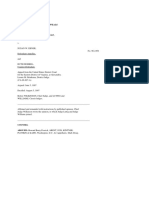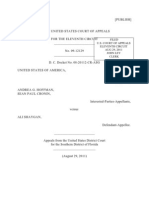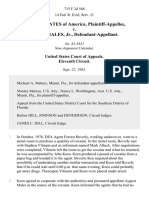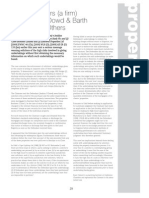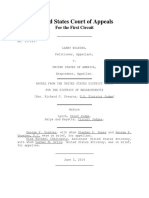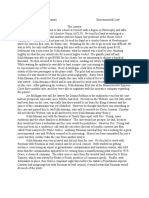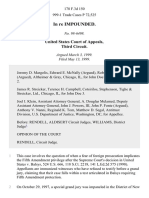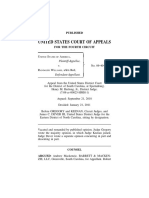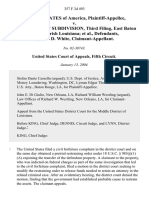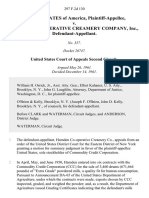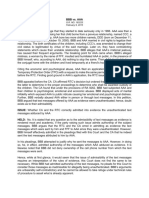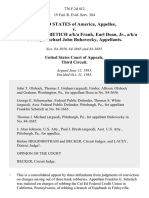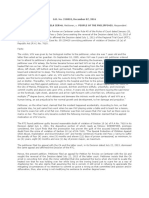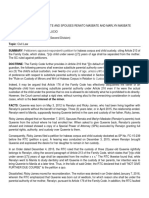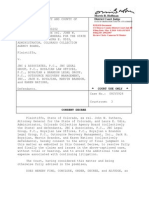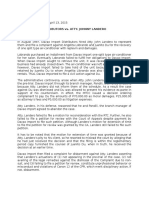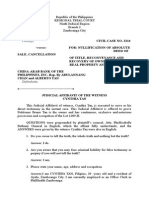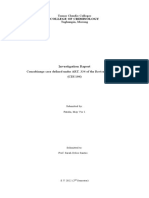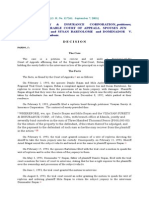Civil Action Summary
Civil Action Summary
Uploaded by
roxskulet7Copyright:
Available Formats
Civil Action Summary
Civil Action Summary
Uploaded by
roxskulet7Copyright
Available Formats
Share this document
Did you find this document useful?
Is this content inappropriate?
Copyright:
Available Formats
Civil Action Summary
Civil Action Summary
Uploaded by
roxskulet7Copyright:
Available Formats
A Brief Summary of A Civil Action Chapters 1 and 2: The Woburn Families From 1966 to 1986, more than a dozen
cases of childhood leukemia hit the small town of Woburn, Massachusetts. In the late 1970s, civil engineers discovered that local wells G and H were contaminated with several suspected carcinogens, including trichloroethylene (TCE). The wells were subsequently shut down. The town had a long history of industrial activity, including a number of tanneries. Two major corporations, W.R. Grace Co. and Beatrice Foods, owned factories and plants in the area. A group of the parents of children who had developed leukemia (some survived, though many died) sought legal advice. They consulted Joe Mulligan, a Boston lawyer, and signed his firm to a contingency contract to pursue a suit against anyone responsible for the contamination of the local wells. In early 1981, the Center for Disease Control issued a report on the Woburn cancer cluster that showed the cancer rate was at least seven times higher than normal, but did not definitively connect the well contamination with the leukemia cases. Chapter 3: The Lawyer Jan Schlictmann was a young lawyer with Joe Mulligans law firm, Reed & Mulligan, early in the Woburn case. He had bounced around a number of jobs before discovering an interest in the law and attending law school. He attempted to start his own firm, but ended up working at Reed & Mulligan in Boston only a few years later. The Woburn case had been neglected at the firm, and Schlictmann began working on it. He worked closely with Kevin Conway at the firm, who warned him that the Woburn case was a black hole. As the statute of limitations on the case approached, Schlictmann teamed up with a non-profit firm in Washington, DC, that was looking for an environmental case to pursue. He turned the case over to the firm but stayed on as local counsel. They filed a complaint eight days before the statute of limitations ran in May 1982, claiming that Beatrice Foods and the W.R. Grace Company were responsible for contaminating the wells and thereby causing the leukemia cluster in Woburn. Chapter 4: Rule 11 Jerome Facher was an experienced trial lawyer in Boston. His firm represented Beatrice Foods, which owned the Riley Tannery north of Woburn. William Cheeseman worked for another large Boston firm that represented W.R. Grace Co., which owned a manufacturing plant north of Woburn. Cheeseman specialized in pre-trial strategy rather than trials, and filed a Rule 11 motion against Schlictmann and the firm in an effort to end the case immediately. The motion charged Schlictmann with filing a frivolous and unfounded lawsuit, and with other suspect ethical behavior such as soliciting clients. The judge, Walter Jay Skinner, held a hearing on the motion. Schlictmann refused to submit to cross-examination by Cheeseman on the theory that doing so would violate his obligations to his clients. The hearing was conducted by Judge Skinner based on submitted questions by Cheeseman, and the Rule 11 motion was denied.
Chapter 5: Orphans and Dogs After successfully negotiating a large settlement in a different case, and seeing the credit and most of the proceeds go to a senior partner who had little to do with the case, Schlictmann decided to leave Reed & Mulligan and start his own firm. Kevin Conway went with him, and requested that Schlictmann get rid of the Woburn case, but Schlictmann refused. In the new firms first major case, Schlictmann won a then-state-record $4.7 million verdict in a personal injury case. He turned his attention to the Woburn case, which had lain dormant for over a year. A Harvard study had come out showing that people exposed to wells G and H had suffered a number of adverse health effects, and the study concluded that there was a strong possibility the contamination was linked to the leukemia cases. William Cheeseman filed a motion for summary judgment, alleging that the plaintiffs could not prove their allegations scientifically, and therefore the case could not go to a jury. Judge Skinner denied the motion. Cheeseman later impleaded another defendant, Unifirst, who also had a manufacturing plant near the wells. Unifirst quickly settled with Schlictmann for just over a million dollars, and the Woburn families agreed to use a large portion of that settlement to finance the rest of the case against W.R. Grace and Beatrice Foods. Chapter 6: Discovery Both sides began conducting depositions. After hearing some of the family members, Jerome Facher feared that he would lose the case if the families were allowed to testify. Depositions of workers at the plants revealed that some chemicals had been dumped into the ground, and that some managers who had been deposed early in the case had withheld information or lied. Based on this, Schlictmann notified the U.S. Attorney, and a federal investigation began. Further discovery showed that a significant amount of chemicals had been disposed of directly into the ground. Schlictmann deposed John Riley, owner of the Riley Tannery, who denied using TCE and denied any knowledge of polluting the 15 acres of land around the factory. Depositions of other townspeople showed that dumping had taken place for years on the 15 acres Riley owned, but Schlictmann was not able to uncover much of anything in terms of documentation or written evidence. Chapter 7: The Woodshed Schlictmanns firm collected medical records from as many of the family members as possible. He hired medical experts to review the documents and to potentially testify at trial. The firms bills related to the case mounted, in part because Schlictmann spared no expense on experts, medical tests, geological tests of the dump sites, and exhibits to be prepared for trial. With five months left before trial, the firm had spent almost a million dollars on the case. It had to borrow money repeatedly to continue to finance the case. During depositions of the plaintiffs experts, Schlictmann objected strongly to certain lines of questioning, which he thought the lawyers had all agreed not to pursue until a later date. Following Schlictmanns profanity-laced tirades in the deposition room, Jerome Facher filed a motion to have Judge Skinner censure Schlictmann. Judge Skinner strongly rebuked Schlictmann for his unseemly behavior in the depositions, but did not censure him. Following the conference with the judge, Facher
attempted to begin negotiations with Schlictmann. Schlictmann refused to identify a number at which he would settle, even after Facher offered a settlement on the order of one million dollars. Chapter 8: Billion-Dollar Charlie On the advice of several other lawyers, Schlictmann sought the assistance of a Harvard law professor, Charlie Nesson. Nesson decided to join the legal team as a consultant. In a meeting with Schlictmanns firm, he suggested that the case could be worth far more than they had originally thought. If punitive damages were given, the verdict could reach into the hundreds of millions of dollars, rather than the ten or twenty million the lawyers had been discussing previously. Even the judge mused at one point that the case could be worth an astronomical amount. Depositions continued, and Schlictmann deposed the several dozen expert witnesses the defense lawyers had found. These experts disagreed with Schlictmanns experts, saying that TCE and other chemicals in the water were not present in high enough concentrations to cause the effects observed in the Woburn children. Much of the testimony focused on the lack of proof of causation, because no one had ever discovered what caused acute lymphocytic leukemia in children. Meanwhile, the EPA began pump tests at wells G and H to see if groundwater from the factory sites had reached the wells. The data suggested it had. Schlictmanns finance guru Gordon calculated the costs-to-date of the case at over $1.8 million, but thought that the firm could survive until trial as long as there was no postponement. Chapter 9: Fachers Plea As the scheduled pre-trial conference with the judge approached, Jerome Facher realized that he was not ready to try the case. There were over 20,000 pages of records and depositions, and nearly fifty experts, some of whose names he did not know. He decided to seek a continuance, and filed a 20-page affidavit to the judge describing the complexity of the case and the amount of evidence to be sorted, and asked for a seven-month continuance. At the hearing, Judge Skinner refused to grant the continuance despite Fachers pleas. At Judge Skinners request, Schlictmanns team prepared a settlement demand. Their demand totaled $175 million in a structured settlement over 30 years. They hosted the defense teams at a hotel banquet hall and presented the case and their demand. Jerome Facher asked to keep the hotelprovided pen, then walked out of the room, followed by the other defense lawyers. Jury selection began two weeks later, in February 1986. Just after the jury was selected, Judge Skinner held a conference about the structure of the trial. Schlictmann had expected to present his case however he saw fit. Charlie Nesson proposed a test case of one family. Jerome Facher proposed a bifurcated trial, first on the issue of whether the companies had polluted the groundwater, and second on the issue of medical causation. Judge Skinner decided to use Fachers plan, which meant that the first half of the trial would be a battle of the experts on complex hydrological issues, and the families would not go on the witness stand before the second half (if it occurred at all).
Just before trial, a member of Fachers team tried again to settle with Schlictmann. He offered $4 million total for a dismissal of Beatrice Foods. When Schlictmann did not accept, he offered to try to get $8 million. Schlictmann decided to counter-offer before taking the offer to his clients. He countered for $18 million, but never heard back from the defendants. Chapter 10: The Trial The trial began with a packed courtroom. Schlictmanns opening statement was extremely powerful, and left the defense lawyers worried. Facher and Cheeseman both countered with statements focused on the lack of proof of contamination by the companies. Schlictmann presented his case against the companies, with frequent objections from the defense lawyers. Schlictmann called John Riley, the owner of the tannery, to the stand, with plans to expose him as a liar. Schlictmann was unable to get anything useful out of Riley, and began asking questions that violated rules of evidence and gave Riley room to explain answers in a positive light. Schlictmann had more success with his examination of witnesses regarding W.R. Grace. As the trial went on, the firms finances degraded. The phones were cut off at one point, and creditors were in constant communication demanding payment. Eight weeks into trial, Schlictmann called one of his key witnesses, a groundwater expert named George Pinder. Pinder testified about how the contaminants had traveled through the groundwater to the wells. On cross-examination, however, Facher used Pinders deposition to contradict many points Pinder had raised on the witness stand. Facher dissected Pinders calculations and explanations, which were in some parts clearly mistaken. Pinders opinion that the wells drew water from the contaminated land was later shown to be correct by an EPA report, but the report was published two years after the trial. The defense began presenting its case in June. Meanwhile, Schlictmanns firm settled another small case and used the funds to pay off its most pressing bills. Fachers experts disputed the timing of the contamination and shared work that showed Beatrice Foods could not have contaminated the well water before the wells were shut down. Schlictmanns cross examinations were effective in weakening their testimony, and he nearly succeeded in having several of the witnesses testimony stricken from the record. Schlictmanns firm was so deep in debt at this point that all employees were walking to work, Schlictmanns car had been seized, and his condo and several homes of partners in the firm had been signed away as collateral for bank loans. The last witness for the defense was a hydrology expert who testified that water could not have gotten from W.R. Graces land to the wells. His testimony was very troublesome for Schlictmann, but Schlictmann was able to force him into admitting that Beatrice Foods land probably did contaminate the wells. Then Charlie Nesson showed that the experts calculations were wrong, and Schlictmann was able to entirely discredit his testimony just as the trial came to a close. Following the close of evidence, Judge Skinner ruled on several motions for a directed verdict. His rulings excluded some evidence that undercut the plaintiffs case against Beatrice Foods but had no effect on the case against W.R. Grace. Judge Skinner then worked with the lawyers to prepare questions
for the jury to consider in coming to a verdict. Closing statements began on the 77th day of the trial. The defense lawyers spoke first, discussing the lack of proof that contaminants had made it from the land to the wells. Schlictmanns closing statement was interrupted by objections from Facher, and even his partners found his closing confusing and without direction. Chapter 11: The Vigil The jury began deliberations after receiving instructions from Judge Skinner. Their deliberations lasted over two weeks, in part because of confusion over the questions they were expected to answer. At one point, the jury told the judge they were deadlocked and could not reach a decision, but after a few more days they were able to agree. The jury found that there was not enough evidence to find Beatrice Foods liable, but that there was enough to find W.R. Grace liable for polluting the wells. One key finding from the jury stated that W.R. Grace could not be held responsible for any contamination before September 1973, which meant that three of the children who had developed leukemia before 1973 would probably be dropped from the case in the second phase of the trial. Schlictmanns partners realized that their only hope for victory was to settle the case. Chapter 12: The Settlement After the jury verdict in the trials first phase, Schlictmann and his partners met to discuss what they would settle the case for. They met with an executive from W.R. Grace and presented a demand totaling $35 million. The executive said it was too high but it was a constructive proposal. They met again in New York the following week. The executive offered them $6.6 million. Schlictmanns partners insisted he take it, or at least ask the families, but Schlictmann refused. After another week, Schlictmann met again with the executive, and presented a demand of $16 million. The executive took several days to confer with the board of directors, but never returned an offer. Schlictmanns firm was deep in debt and on the edge of bankruptcy. At the beginning of the second phase of the trial, the W.R. Grace defense team submitted motions to dismiss some of the plaintiffs whose children had gotten sick before 1973. On the day of the expected ruling, Schlictmann asked the judge to wait to give them a chance to settle the case. The judge agreed. W.R. Grace came back with an offer of $8 million, which Schlictmanns firm accepted. Chapter 13: Blindmans Buff The settlement money was divided among the families after $2.6 million paid off the expenses of the trial, and $2.2 million went to the firm as legal fees. Each family received just under $500,000. The EPA report came out after the trial, and showed that both Beatrice Foods and W.R. Grace had contaminated the well water. In preparing an appeal, Schlictmanns partners found a document that had not been given to them during trial. The report showed significant testing by W.R. Grace at the site that revealed evidence bolstering the plaintiffs case. Schlictmann sought a new trial based on the withholding of the document, but Judge Skinner denied the motion. The appeal decision came back upholding the verdict but requiring Judge Skinner to delve further into the issue of the withheld report.
The misconduct hearing lasted two months and involved 26 witnesses. In the process, Schlictmann revealed that John Riley had lied on the stand during trial and withheld other documents. At the end of the hearing, Judge Skinner found that Riley had committed perjury, his personal lawyer Mary Ryan had committed professional misconduct, but that Facher and his team had not. The judge also found that Schlictmann had violated Rule 11, and therefore refused to sanction Mary Ryan. Schlictmann appealed to the Court of Appeals and to the Supreme Court but was refused by both. Schlictmann eventually filed for bankruptcy, owing over $1.2 million to various creditors. At about the same time, the EPA filed suit against Beatrice and W.R. Grace to pay for a $69 million clean-up effort in the Woburn area. Both companies agreed to pay their share of the costs. Schlictmann flew to Hawaii on borrowed money and spent a few days in cheap hotels. He then swam out into the ocean as far as he could and nearly decided to commit suicide, but changed his mind and returned to land.
You might also like
- Woburn - A Civil Action by Jonathan HarrDocument1 pageWoburn - A Civil Action by Jonathan HarrEveBNo ratings yet
- Formal Offer of EvidenceDocument3 pagesFormal Offer of EvidenceInnah Agito-RamosNo ratings yet
- Answer To Order To Show CauseDocument23 pagesAnswer To Order To Show Causepanamahunt22No ratings yet
- Annex 1 Counter-Affidavit of MaulaDocument4 pagesAnnex 1 Counter-Affidavit of MaulaDerek C. EgallaNo ratings yet
- A Civil ActionDocument15 pagesA Civil ActionZaijen ParNo ratings yet
- A Civil Action Orphans & Dogs: Jonathan HarrDocument2 pagesA Civil Action Orphans & Dogs: Jonathan HarrRgenieDictadoNo ratings yet
- Michigan PPOsDocument42 pagesMichigan PPOsStinkiePhish100% (5)
- A Civil Action Rule 11Document1 pageA Civil Action Rule 11Jay TabuzoNo ratings yet
- Rule 11 - A Civil Action by Jonathan HarrDocument1 pageRule 11 - A Civil Action by Jonathan HarrEveBNo ratings yet
- Chapter: Billion-Dollar - Charlie SummaryDocument2 pagesChapter: Billion-Dollar - Charlie SummaryRgenieDictadoNo ratings yet
- Petitioner vs. vs. Respondents: First DivisionDocument12 pagesPetitioner vs. vs. Respondents: First DivisionGael MoralesNo ratings yet
- A.A Hoehling v. Universal Studios IP DigestDocument2 pagesA.A Hoehling v. Universal Studios IP Digestnicole hinanayNo ratings yet
- Administrative Decision No. V (US v. Germany) RIAA 119 (1924)Document7 pagesAdministrative Decision No. V (US v. Germany) RIAA 119 (1924)Bianca Paloma0% (1)
- Uy Hu & Co. v. The Prudential Assurance Co., Ltd.Document3 pagesUy Hu & Co. v. The Prudential Assurance Co., Ltd.Keangela LouiseNo ratings yet
- Book Review - A Civil Action - Billion-Dollar CharlieDocument1 pageBook Review - A Civil Action - Billion-Dollar CharlieStan AileronNo ratings yet
- Orphans and DogsDocument1 pageOrphans and DogsArgel CosmeNo ratings yet
- Orphans and Dogs - A Civil Action by Jonathan HarrDocument1 pageOrphans and Dogs - A Civil Action by Jonathan HarrEveBNo ratings yet
- Mariline M. Lee LSOCRES Atty. Pe Benito: Chapter 5 - Orphans and DogsDocument1 pageMariline M. Lee LSOCRES Atty. Pe Benito: Chapter 5 - Orphans and DogsMariline LeeNo ratings yet
- A Civil ActionDocument5 pagesA Civil ActionBenjamin Cruz RoqueNo ratings yet
- Erin BrockovichDocument12 pagesErin BrockovichMylene MorlaNo ratings yet
- Book Review - Orphans and DogsDocument1 pageBook Review - Orphans and DogsSarah CruzNo ratings yet
- Riley v. Harr, 292 F.3d 282, 1st Cir. (2002)Document23 pagesRiley v. Harr, 292 F.3d 282, 1st Cir. (2002)Scribd Government DocsNo ratings yet
- De Jesus - The NegotiationDocument1 pageDe Jesus - The NegotiationRose De JesusNo ratings yet
- LM Project Sem 1 UKS & K. ManasDocument19 pagesLM Project Sem 1 UKS & K. ManasKrishna SankarNo ratings yet
- PALEN Midterm MarilineLeeDocument4 pagesPALEN Midterm MarilineLeeMariline LeeNo ratings yet
- United States v. James R. Monaco and Eugene O. Hicks, 702 F.2d 860, 11th Cir. (1983)Document38 pagesUnited States v. James R. Monaco and Eugene O. Hicks, 702 F.2d 860, 11th Cir. (1983)Scribd Government DocsNo ratings yet
- United States Court of Appeals For The Third CircuitDocument16 pagesUnited States Court of Appeals For The Third CircuitScribd Government DocsNo ratings yet
- United States Court of Appeals Tenth CircuitDocument9 pagesUnited States Court of Appeals Tenth CircuitScribd Government DocsNo ratings yet
- "MacFarlane and Another V Tayside Health Board (2000) 2 AC 59Document8 pages"MacFarlane and Another V Tayside Health Board (2000) 2 AC 59LAW MANTRA100% (1)
- United States v. Capelton, 350 F.3d 231, 1st Cir. (2003)Document18 pagesUnited States v. Capelton, 350 F.3d 231, 1st Cir. (2003)Scribd Government DocsNo ratings yet
- In Re A.H. Robins Company, Incorporated, Debtor, 880 F.2d 709, 4th Cir. (1989)Document114 pagesIn Re A.H. Robins Company, Incorporated, Debtor, 880 F.2d 709, 4th Cir. (1989)Scribd Government DocsNo ratings yet
- United States v. Angelo Chieppa, Abe Ivicola, Anthony Petti, and Joseph D. Polverino, 241 F.2d 635, 2d Cir. (1957)Document8 pagesUnited States v. Angelo Chieppa, Abe Ivicola, Anthony Petti, and Joseph D. Polverino, 241 F.2d 635, 2d Cir. (1957)Scribd Government DocsNo ratings yet
- Wolfsen Land & Cattle Co. v. United States, No. 2011-5113 (Sep. 21, 2012)Document23 pagesWolfsen Land & Cattle Co. v. United States, No. 2011-5113 (Sep. 21, 2012)RHTNo ratings yet
- American Tank Transport, Incorporated v. First People's Community Federal Credit Union Paul C. Herring, 86 F.3d 1148, 1st Cir. (1996)Document12 pagesAmerican Tank Transport, Incorporated v. First People's Community Federal Credit Union Paul C. Herring, 86 F.3d 1148, 1st Cir. (1996)Scribd Government DocsNo ratings yet
- Red Hill ComplaintDocument109 pagesRed Hill ComplaintHonolulu Star-AdvertiserNo ratings yet
- Enron CDocument10 pagesEnron CTilak SahooNo ratings yet
- United States v. Private Brands, Inc., and Francis P. Carey, 250 F.2d 554, 2d Cir. (1958)Document5 pagesUnited States v. Private Brands, Inc., and Francis P. Carey, 250 F.2d 554, 2d Cir. (1958)Scribd Government DocsNo ratings yet
- TORTDocument27 pagesTORTkarthikeyan cocNo ratings yet
- WilliamsDocument4 pagesWilliamszubiagaericNo ratings yet
- Hatfill v. New York Times Co, 4th Cir. (2005)Document10 pagesHatfill v. New York Times Co, 4th Cir. (2005)Scribd Government DocsNo ratings yet
- CivilAction Summary - Atty. PebenitoDocument15 pagesCivilAction Summary - Atty. PebenitoMariline LeeNo ratings yet
- CivilAction SummaryDocument15 pagesCivilAction SummaryMariline LeeNo ratings yet
- United States v. Satiris G. Fassoulis, 445 F.2d 13, 2d Cir. (1971)Document8 pagesUnited States v. Satiris G. Fassoulis, 445 F.2d 13, 2d Cir. (1971)Scribd Government DocsNo ratings yet
- United States v. Regents of New Mexico School of MinesDocument4 pagesUnited States v. Regents of New Mexico School of MinesScribd Government DocsNo ratings yet
- In Re Grand Jury Subpoena Duces Tecum Dated April 19, 1991. United States of America v. John Doe, Esq., Continental Holdings, Inc., and Continental Airlines, Inc., Intervenors-Appellants, 945 F.2d 1221, 2d Cir. (1991)Document8 pagesIn Re Grand Jury Subpoena Duces Tecum Dated April 19, 1991. United States of America v. John Doe, Esq., Continental Holdings, Inc., and Continental Airlines, Inc., Intervenors-Appellants, 945 F.2d 1221, 2d Cir. (1991)Scribd Government DocsNo ratings yet
- DynTel Corporation v. Ebner, 4th Cir. (1997)Document10 pagesDynTel Corporation v. Ebner, 4th Cir. (1997)Scribd Government DocsNo ratings yet
- Filed U.S. Court of Appeals Eleventh Circuit AUG 29, 2011 John Ley ClerkDocument63 pagesFiled U.S. Court of Appeals Eleventh Circuit AUG 29, 2011 John Ley Clerkarogers8239No ratings yet
- United States v. August Males, JR., 715 F.2d 568, 11th Cir. (1983)Document7 pagesUnited States v. August Males, JR., 715 F.2d 568, 11th Cir. (1983)Scribd Government DocsNo ratings yet
- Angel Solicitors (A Firm) V Jenkins O'Dowd & Barth (A Firm) and Others by Ryan Clement BarristerDocument1 pageAngel Solicitors (A Firm) V Jenkins O'Dowd & Barth (A Firm) and Others by Ryan Clement BarristerRyan Clement100% (1)
- Chapter 8: Billion-Dollar CharlieDocument1 pageChapter 8: Billion-Dollar CharlieAnonymous qVilmbaMNo ratings yet
- United States Court of Appeals: For The First CircuitDocument14 pagesUnited States Court of Appeals: For The First CircuitScribd Government DocsNo ratings yet
- United States Court of Appeals, Fourth Circuit.: Nos. 76-2323, 76-2324, 76-2325 and 77-1504Document13 pagesUnited States Court of Appeals, Fourth Circuit.: Nos. 76-2323, 76-2324, 76-2325 and 77-1504Scribd Government DocsNo ratings yet
- The Lawyer - A Civil Action by Jonathan HarrDocument1 pageThe Lawyer - A Civil Action by Jonathan HarrEveBNo ratings yet
- United States Court of Appeals, Third CircuitDocument15 pagesUnited States Court of Appeals, Third CircuitScribd Government DocsNo ratings yet
- In Re Impounded, 178 F.3d 150, 3rd Cir. (1999)Document14 pagesIn Re Impounded, 178 F.3d 150, 3rd Cir. (1999)Scribd Government DocsNo ratings yet
- In Re Federal Savings and Loan Insurance Corporation and Glenn M. Young, 852 F.2d 565, 4th Cir. (1988)Document8 pagesIn Re Federal Savings and Loan Insurance Corporation and Glenn M. Young, 852 F.2d 565, 4th Cir. (1988)Scribd Government DocsNo ratings yet
- United States Court of Appeals, Tenth CircuitDocument13 pagesUnited States Court of Appeals, Tenth CircuitScribd Government DocsNo ratings yet
- United States v. Robert Cohen and Samuel Cohen, 888 F.2d 770, 11th Cir. (1989)Document10 pagesUnited States v. Robert Cohen and Samuel Cohen, 888 F.2d 770, 11th Cir. (1989)Scribd Government DocsNo ratings yet
- United States v. Williams, 632 F.3d 129, 4th Cir. (2011)Document34 pagesUnited States v. Williams, 632 F.3d 129, 4th Cir. (2011)Scribd Government DocsNo ratings yet
- United States v. Melrose East Subdivision, Third Filing, East Baton Rouge Parish Louisiana, Lyman D. White, Claimant-Appellant, 357 F.3d 493, 3rd Cir. (2004)Document20 pagesUnited States v. Melrose East Subdivision, Third Filing, East Baton Rouge Parish Louisiana, Lyman D. White, Claimant-Appellant, 357 F.3d 493, 3rd Cir. (2004)Scribd Government DocsNo ratings yet
- Background Memo On Ecuador Case As Nobel Laureates Announce Support For Steven DonzigerDocument6 pagesBackground Memo On Ecuador Case As Nobel Laureates Announce Support For Steven Donzigern kNo ratings yet
- United States v. Harold Oxman, United States of America v. William H. Pflaumer, 740 F.2d 1298, 3rd Cir. (1984)Document39 pagesUnited States v. Harold Oxman, United States of America v. William H. Pflaumer, 740 F.2d 1298, 3rd Cir. (1984)Scribd Government DocsNo ratings yet
- United States v. Hamden Co-Operative Creamery Company, Inc., 297 F.2d 130, 2d Cir. (1961)Document6 pagesUnited States v. Hamden Co-Operative Creamery Company, Inc., 297 F.2d 130, 2d Cir. (1961)Scribd Government DocsNo ratings yet
- Photog RatesDocument6 pagesPhotog Ratesroxskulet7No ratings yet
- Alcasid Vs SamsonDocument4 pagesAlcasid Vs Samsonroxskulet7No ratings yet
- Oblicon Reviewer From ScribdDocument62 pagesOblicon Reviewer From ScribdAngela SuttonNo ratings yet
- Nachura Digests-1st Batch Friendly)Document58 pagesNachura Digests-1st Batch Friendly)BAROPS100% (2)
- Woodhill v. HaliliDocument2 pagesWoodhill v. HaliliNei BacayNo ratings yet
- BBB Vs AAA (Electronic Evidence)Document1 pageBBB Vs AAA (Electronic Evidence)RainNo ratings yet
- United States v. Franklin Evon Sebetich A/K/A Frank, Earl Dean, JR., A/K/A Dooney, Michael John Buhovecky, 776 F.2d 412, 3rd Cir. (1985)Document26 pagesUnited States v. Franklin Evon Sebetich A/K/A Frank, Earl Dean, JR., A/K/A Dooney, Michael John Buhovecky, 776 F.2d 412, 3rd Cir. (1985)Scribd Government DocsNo ratings yet
- January 16, 2017 G.R. No. 213224 PEOPLE OF THE PHILIPPINES, Plaintiff-Appellee, Roque Dayaday Y DagoocDocument1 pageJanuary 16, 2017 G.R. No. 213224 PEOPLE OF THE PHILIPPINES, Plaintiff-Appellee, Roque Dayaday Y DagoocbertNo ratings yet
- Vakalatnama: IN THE COURT OF - , NEW DELHI CASE NO. - OF 2019Document1 pageVakalatnama: IN THE COURT OF - , NEW DELHI CASE NO. - OF 2019HAS and AssociatesNo ratings yet
- Petitioner Vs Vs Respondent: Third DivisionDocument12 pagesPetitioner Vs Vs Respondent: Third Divisionaspiringlawyer1234No ratings yet
- LTOPF FORM+New PDFDocument1 pageLTOPF FORM+New PDFVic SomozaNo ratings yet
- 1-9 Civil Law CasesDocument34 pages1-9 Civil Law CasesLyleThereseNo ratings yet
- O39R7Document41 pagesO39R7Banerjee SuvranilNo ratings yet
- Complaint AffidavitDocument2 pagesComplaint AffidavitDe Dios JVNo ratings yet
- PP V DALAGDocument2 pagesPP V DALAGMiguel CastricionesNo ratings yet
- Rules of Criminal Procedure Rules 110 - 127: CertiorariDocument49 pagesRules of Criminal Procedure Rules 110 - 127: CertiorarijwualferosNo ratings yet
- RICARDO DEL POSO V PEOPLE GR 210810Document2 pagesRICARDO DEL POSO V PEOPLE GR 210810Therese Mamaoag100% (1)
- Masbate vs. Relucio DigestDocument3 pagesMasbate vs. Relucio DigestEmir Mendoza100% (5)
- PFR Lopez RosarioDocument50 pagesPFR Lopez RosarioOmni Gruba100% (1)
- People V SayoDocument17 pagesPeople V SayobogoldoyNo ratings yet
- JBC Consent DecreeDocument12 pagesJBC Consent DecreeCircuit MediaNo ratings yet
- Allstate FilingDocument9 pagesAllstate FilingLaw&CrimeNo ratings yet
- A.C. No. 5116Document3 pagesA.C. No. 5116Cid Benedict PabalanNo ratings yet
- Judicial Affidavit of CYNTHIA TANDocument4 pagesJudicial Affidavit of CYNTHIA TANAlmanov GreenNo ratings yet
- Rule 57, Sec 13 Uy Kimpang Case DigestDocument1 pageRule 57, Sec 13 Uy Kimpang Case DigestNathalie QuinonesNo ratings yet
- Tomas Claudio Colleges Taghangin, Morong: Investigation ReportDocument11 pagesTomas Claudio Colleges Taghangin, Morong: Investigation ReportMay Ver PateñaNo ratings yet
- Pale DigestDocument5 pagesPale DigestAnn Yap100% (1)
- Burden of Proof and Burden of EvidenceDocument1 pageBurden of Proof and Burden of EvidencejeiromeNo ratings yet
- Visayan Surety Vs CADocument3 pagesVisayan Surety Vs CAAzrael CassielNo ratings yet
- 10-Miguel v. MontanezDocument7 pages10-Miguel v. MontanezEunice NavarroNo ratings yet
- Kasey HughesDocument59 pagesKasey HughesWilliam N. GriggNo ratings yet
